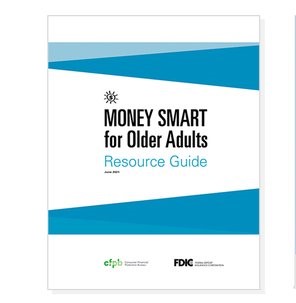One of the most critical risks facing older Americans, and indeed, Americans of all ages, is the problem of fraud. Fraud is devastating to the financial security of older Americans. The most conservative estimates translate into at least 4 million financial exploitation cases per year for people ages 60 and older.
A TrueLink study found that 37% of older adults were victims of elder financial exploitation (EFE) in a five-year period, and average monetary losses were higher among low-income older adults. Estimates of annual financial losses from EFE vary from $2.9 billion to $36.5 billion, and these impacts increase every year.
That is why the Consumer Financial Protection Bureau (CFPB) is working to combat these issues and why I want to share how you can help combat EFE at the local level.
Role of the CFPB
The CFPB’s Office for Older Americans works to protect consumers ages 62 and older from financial harm and to help people navigate key financial moments as we grow older. Our office identifies emerging consumer protection risks and coordinates with federal agencies and state regulators to promote consistent, effective and efficient enforcement.
I am motivated in my work for older adults by honoring the memory of my mother and father. Elder financial exploitation, scams and caregiving are topics that resonate with me both professionally and personally. Professionally, before the CFPB, I served as General Counsel to the D.C. Department of Aging and Community Living, and as CEO of Seabury Resources for Aging, where I saw first-hand the challenges that many people faced when dealing with caregiving issues and financial protection of their older loved ones.
Personally, I was a caregiver for my mother until her death in September 2020 at 101. More recently, perpetrators have been targeting older people in my neighborhood with imposter scams involving so-called investments in gold bars, resulting in devastating financial losses and shocking in-person collection efforts.
This is why I work at the CFPB’s Office for Older Americans: to honor my beloved parents, and to support other older adults and their families in living comfortably, independently and with respect, dignity and joy. I believe that growing older should be time of joy, nurturing connections with family and friends, discovery, and reinvention.
In this article, I will focus on elder financial exploitation prevention—what the CFPB is doing to combat EFE, as well as ways ASA members might combat EFE in their communities.
National Efforts—What the CFPB Is Doing
The CFPB is working to combat EFE in a variety of ways, including enforcement, research, collaboration, and policy priorities.
In enforcement, the CFPB held BrightSpeed, a payment processor, accountable for its role in allowing tech support scammers to use its digital payment platform to scam older consumers. BrightSpeed gave financial predators the tools to take advantage of consumers, particularly older Americans who are disproportionally affected by tech support scams. The CFPB’s settlement ensures that BrightSpeed will never again participate in the payment processing industry and shows the CFPB’s determination to hold predatory payment processors like BrightSpeed accountable. The CFPB will continue monitoring financial service providers to ensure their compliance with consumer laws.
When it comes to national efforts, the CFPB has a multipronged effort using all the tools in our toolbox, including enforcement, research, collaboration, and policy.
In research last year, the CFPB released an elder financial exploitation recovery framework report, which outlines factors that affect how and when people get their money back after having lost it to EFE. The report presents a framework for financial recovery derived from insights from CFPB’s interviews with older adults, caregivers and professionals, as well as a review of existing literature. The EFE financial recovery framework consists of a series of hypotheses on the key factors that can make recovery more or less likely at four stages: 1) identification that EFE has occurred; 2) reporting of suspected EFE to authorities; 3) investigation of suspected EFE; and 4) return of funds to the victim. The report also outlines implications for policy and research.
When it comes to collaboration, for years, the CFPB has been convening local and state entities to build better systems and enable a collaborative response to EFE. Through our network development program, we have helped key stakeholders like law enforcement, adult protective services and financial institutions work together to build elder fraud prevention and response networks in more than 20 states. We also developed an online network development guide, available at consumerfinance.gov/eldernetworks, which can help ASA members start or grow a network in their area.
Through our policy work, we aim to enhance financial institutions’ accountability. For example, the CFPB released new resources for financial institutions and consumers about choosing a trusted contact person to be alerted when financial institution staff suspects EFE, including scams. The CFPB also released a data spotlight on Suspicious Activity Reports (SARs) involving EFE, which includes information about SARs filed by financial institutions in 2020 to show how trends changed during the pandemic.
When it comes to national efforts, the CFPB has a multipronged effort using all the tools in our toolbox including enforcement, research, collaboration, and policy.
Local Empowerment: What ASA Members Can Do
Now that I’ve described our national efforts, I want to turn to what ASA members can do in their community to combat EFE. The CFPB cannot do this alone. It takes collaborating with people throughout the country at the state and local level as well. There are many avenues for local empowerment including joining networks; teaching people in the community how to recognize and avoid fraud and scams; and spreading the word about reporting.
As explained above, the CFPB’s network project combats EFE by bringing together key stakeholders at the local level. Using our materials, one can start a network or grow one. The CFPB’s network development guide and videos offer perspectives on best practices for creating and growing networks. One can also find a YouTube network playlist including videos on best practices for networks, as well as substantive trainings.
Another thing to do at the local level—and many probably already do this—is share knowledge about scams to help protect others. One can use free CFPB resources such as Money Smart for Older Adults to help people protect against scams. This is a train-the-trainer scam prevention resource from FDIC and CFPB. We recently updated the resource guide to include romance scams. As part of Money Smart, we also have fraud prevention handouts and placemats, which can be found at consumerfinance.gov/moneysmart.
One more important thing to do at the local level is to encourage reporting. Report scams to reportfraud.ftc.gov. Such reporting can help law enforcement shut down scammers and stop other people from being scammed. Remind people: don’t be ashamed or embarrassed. For complaints about a financial product or service, it can be reported to the CFPB at consumerfinance.gov/complaint.
In closing, I want to thank you, ASA members, for the things you do every day to improve your communities. The CFPB values our collaboration with the American Society on Aging (ASA) and its stakeholders, as a way to understand and address the experiences and challenges of older consumers. Working together, nationally and locally, we can better our communities by combating fraud and scams against older adults.
—–
By Deborah Royster
Assistant director, Office for Older Americans, at the CFPB and former member of ASA’s Board of Directors.
Published November 20, 2024
Read the full report here.
https://generations.asaging.org/elder-financial-exploitationrole-cfpb


